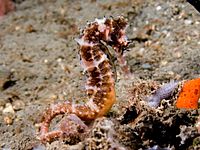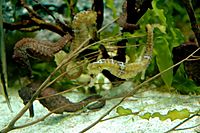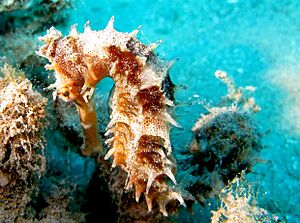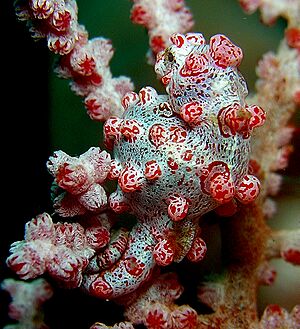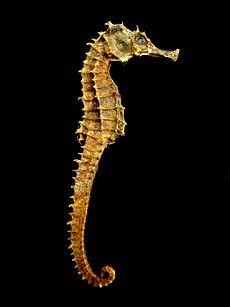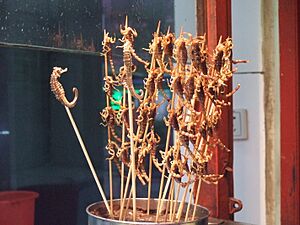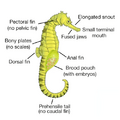Seahorse facts for kids
Quick facts for kids HippocampusTemporal range: Lower Miocene to Present
|
|
|---|---|
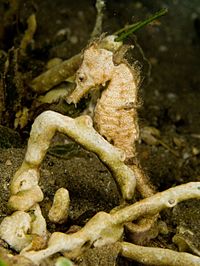 |
|
| Hippocampus sp. | |
| Scientific classification | |
| Kingdom: | |
| Phylum: | |
| Class: | |
| Order: | |
| Family: |
Syngnathidae
|
| Genus: |
Hippocampus
Cuvier, 1816
|
Seahorses are a type of teleost fish. They are in the genus Hippocampus. They are called 'seahorses' because their head looks like a horse's head. There are about 32–48 species of seahorse. Seahorses live in tropical oceans.
Seahorses use camouflage to hide.
Contents
Description
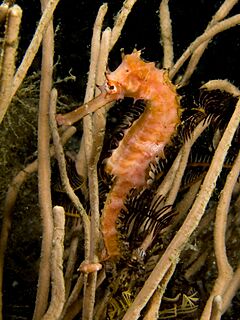
Seahorses range in size from 1.5 to 35 cm (0.6 to 13.8 in). They are named for their equine appearance, with bent necks and long snouted heads and a distinctive trunk and tail. Although they are bony fish, they do not have scales, but rather thin skin stretched over a series of bony plates, which are arranged in rings throughout their bodies. Each species has a distinct number of rings. The armor of bony plates also protects them against predators, and because of this outer skeleton, they no longer have ribs. Seahorses swim upright, propelling themselves using the dorsal fin, another characteristic not shared by their close pipefish relatives, which swim horizontally. Razorfish are the only other fish that swim vertically. The pectoral fins, located on either side of the head behind their eyes, are used for steering. They lack the caudal fin typical of fishes. Their prehensile tail is composed of square-like rings that can be unlocked only in the most extreme conditions. They are adept at camouflage, and can grow and reabsorb spiny appendages depending on their habitat.
Unusual among fish, a seahorse has a flexible, well-defined neck. It also sports a crown-like spine or horn on its head, termed a "coronet", which is distinct for each species.
Seahorses swim very poorly, rapidly fluttering a dorsal fin and using pectoral fins to steer. The slowest-moving fish in the world is H. zosterae (the dwarf seahorse), with a top speed of about 1.5 m (5 ft) per hour. Since they are poor swimmers, they are most likely to be found resting with their prehensile tail wound around a stationary object. They have long snouts, which they use to suck up food, and their eyes can move independently of each other like those of a chameleon.
Communication
Seahorses produce clicking sounds to attract mates and interact with each other. They can also growl in response to stress, but the human ear can't easily detect this sound. In addition, seahorses use body language and pheromones for communication.
Feeding habits

Seahorses use their long snouts to eat their food with ease. However, they are slow to consume their food and have extremely simple digestive systems that lack a stomach, so they must eat constantly to stay alive. Seahorses are not very good swimmers, and for this reason they need to anchor themselves to seaweed, coral or anything else that will keep the seahorse in place. They do this by using their prehensile tails to grasp their object of choice. Seahorses feed on small crustaceans floating in the water or crawling on the bottom. With excellent camouflage seahorses ambush prey that floats within striking range, sitting and waiting until an optimal moment. Mysid shrimp and other small crustaceans are favorites, but some seahorses have been observed eating other kinds of invertebrates and even larval fish. In a study of seahorses, the distinctive head morphology was found to give them a hydrodynamic advantage that creates minimal interference while approaching an evasive prey. Thus the seahorse can get very close to the copepods on which it preys. After successfully closing in on the prey without alerting it, the seahorse gives an upward thrust and rapidly rotates the head aided by large tendons that store and release elastic energy, to bring its long snout close to the prey. This step is crucial for prey capture, as oral suction only works at a close range. This two-phase prey capture mechanism is termed pivot-feeding. Seahorses have three distinctive feeding phases: preparatory, expansive, and recovery. During the preparatory phase, the seahorse slowly approaches the prey while in an upright position, after which it slowly flexes its head ventrally. In the expansive phase, the seahorse captures its prey by simultaneously elevating its head, expanding the buccal cavity, and sucking in the prey item. During the recovery phase, the jaws, head, and hyoid apparatus of the seahorse return to their original positions.
The amount of available cover influences the seahorse's feeding behaviour. For example, in wild areas with small amounts of vegetation, seahorses will sit and wait, but an environment with extensive vegetation will prompt the seahorse to inspect its environment, feeding while swimming rather than sitting and waiting. Conversely, in an aquarium setting with little vegetation, the seahorse will fully inspect its environment and makes no attempt to sit and wait.
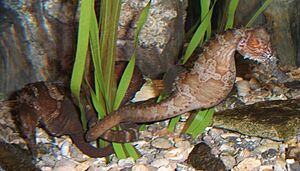
Reproduction
Seahorses are unique because the male hatches the eggs in a pouch on his belly. The female inserts her ovipositor into the male’s brood pouch. She places dozens to thousands of eggs in the pouch. As the female releases her eggs, her body slims while his swells. The male releases his sperm directly into the water. The sperm then fertilize the eggs in the pouch. The fertilised eggs are then embedded in the pouch wall. They get nutrition and oxygen from the fluid in the pouch. In the pouch, the salinity of the water is controlled. This prepares the newborns for life in the sea.
Both animals then sink back into the seagrass and she swims away. The eggs then hatch
Throughout gestation, which in most species requires two to four weeks, his mate visits him daily for 'morning greetings'. They interact for about 6 minutes. The female then swims away until the next morning, and the male vacuums up food through his snout.
Research published in 2007 shows that the males release sperm into the surrounding sea water during fertilization, and not directly into the pouch as previously thought.
Birth
The number of young released by the male seahorse averages 100-200 for most species, but may be as low as 5 for the smaller species, or as high as 1,500.
When the fry are ready to be born, the male expels them with muscular contractions. He gives birth at night and is ready for the next batch of eggs by morning when his mate returns.
Like almost all other fish species, seahorses do not take care of their young after birth. Infants are susceptible to predators or ocean currents which wash them away from feeding grounds or into temperatures too extreme for their bodies. Fewer than 0.5% of infants survive to adulthood. This is why litters are so large. These survival rates are actually fairly high compared to other fish, because of their protected gestation. This makes the process worth the cost to the father. The eggs of most other fish are abandoned immediately after fertilization.
Seahorses are the only fish that experience true male pregnancy.
Threats of extinction
Because data is lacking on the sizes of the various seahorse populations, as well as other issues including how many seahorses are dying each year, how many are being born, and the number used for souvenirs, there is insufficient information to assess their risk of extinction, and the risk of losing more seahorses remains a concern. Some species, such as the paradoxical seahorse, H. paradoxus, may already be extinct. Coral reefs and seagrass beds are deteriorating, reducing viable habitats for seahorses. Additionally, bycatch in many areas causes high cumulative effects on seahorses, with an estimated 37 million individuals being removed annually over 21 countries.
Aquaria
While many aquarium hobbyists keep them as pets, seahorses collected from the wild tend to fare poorly in home aquaria. Many eat only live foods such as brine shrimp and are prone to stress, which damages their immune systems and makes them susceptible to disease.
In recent years, however, captive breeding has become more popular. Such seahorses survive better in captivity, and are less likely to carry diseases. They eat frozen mysidacea (crustaceans) that are readily available from aquarium stores, and do not experience the stress of moving out of the wild. Although captive-bred seahorses are more expensive, they take no toll on wild populations.
Seahorses should be kept in an aquarium with low flow and placid tank mates. They are slow feeders, so fast, aggressive feeders will leave them without food. Seahorses can coexist with many species of shrimp and other bottom-feeding creatures. Gobies also make good tank-mates. Keepers are generally advised to avoid eels, tangs, triggerfish, squid, octopus, and sea anemones.
Water quality is very important for the survival of seahorses in an aquarium. They are delicate species which should not be added to a new tank. The water parameters are recommended to be as follows although these fish may acclimatise to different water over time:
- Temperature: 23–28 °C (73–82 °F)
- pH: 8.1–8.4
- Ammonia: 0 mg/L (0 ppm) (0.01 mg/L (0.01 ppm) may be tolerated for short periods)
- Nitrite: 0 mg/L (0 ppm) (0.125 mg/L (0.125 ppm) may be tolerated for short periods)
- S.G.: 1.021–1.024 at 23–24 °C (73–75 °F)
A water-quality problem will affect fish behaviour and can be shown by clamped fins, reduced feeding, erratic swimming, and gasping at the surface. Seahorses swim up and down, as well as using the length of the aquarium. Therefore, the tanks should ideally be twice as deep as the length of the adult seahorse.
Animals sold as "freshwater seahorses" are usually the closely related pipefish, of which a few species live in the lower reaches of rivers. The supposed true "freshwater seahorse" called H. aimei is not a valid species, but a synonym sometimes used for Barbour's and hedgehog seahorses. The latter, which is often confused with the former, can be found in estuarine environments, but is not actually a freshwater fish.
Consumption
Seahorse populations are thought to be endangered as a result of overfishing and habitat destruction. Despite a lack of scientific studies or clinical trials, the consumption of seahorses is widespread in traditional Chinese medicine.
Images for kids
-
Pregnant male seahorse at the New York Aquarium
-
H. kuda, known as the "common seahorse"
See also
 In Spanish: Hippocampus para niños
In Spanish: Hippocampus para niños


